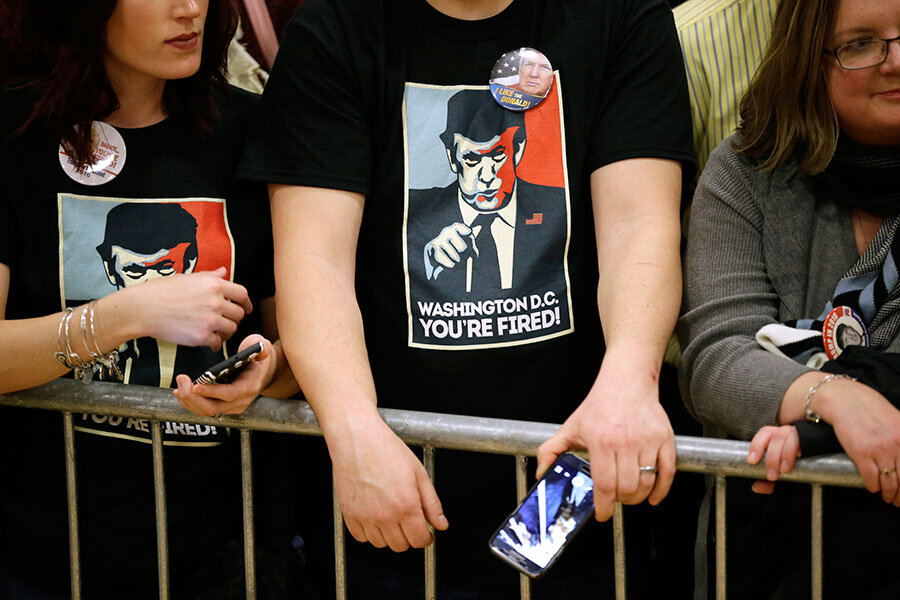Why America might elect a president it doesn't like
Loading...
It is possible, perhaps even probable, that this fall’s election will be contested between two of three most disliked presidential candidates of at least the past quarter century.
And it is possible, perhaps even probable, that this is not a coincidence.
A Gallup survey released Saturday shows that Donald Trump has the highest unfavorability rating (60 percent) of any presidential candidate since the polling firm started tracking the figure in 1992. For her part, Hillary Clinton ranks third (52 percent) with the no-new-taxes-breaking George H.W. Bush of 1992 at No. 2.
In other words, the 2016 presidential election could be decided between two people that the majority of Americans, according to Gallup, don’t like politically.
How is this possible?
Actually, it makes complete sense. In fact, one could argue that such a contest would perfectly befit the current political era.
At a time when partisanship has taken new and more rigid forms, the result has been an America increasingly wary of the other side. Many Americans are increasingly motivated to vote against candidates rather than for them.
Mr. Trump and former Secretary of State Clinton symbolize this shift in different ways, but they speak to the shrinking middle of American politics. As the national parties have less and less in common, their national candidates likewise have less in common, leaving voters with a starker choice that they are just as likely to oppose as embrace.
Indeed, political scientists note that Americans are more neatly “sorted” into the two parties than they have been in recent history. In other words, conservatives support Republicans and liberals support Democrats.
No more “blue dog” Democrats who want to reform welfare. No more Northeast Republicans who want to address climate change.
It means there is a brighter line between the national Democratic and Republican Parties than there has been in decades, because there is less internal pressure to moderate. If, increasingly, everyone in the party is left-of-center (or right-of-center), the party naturally shifts left (or right).
The result is two sharply different visions for America, two sharply different sets of solutions.
Another result is the vanishing swing voter. (See the Monitor’s Cover Story on the subject.) A larger share of American voters might register as independents than as Democrats or Republicans, but they don’t act that way. Those independents who reliably turn out to vote tend to take sides just like the partisans, voting in consistently partisan ways.
“People are more confident in their opinions when they see polarized parties,” Corwin Smidt, a Michigan State University political scientist, told the Monitor. “They think, ‘Well, if the choices are so stark, it’s just not a gray area at all.’ ”
And so they worry about the “other side” winning, according to research by Emory University political scientists Alan Abramowitz and Steven Webster. They found that voting behavior is increasingly guided by this “negative partisanship.”
This fall, it seems, American voters might have a lot to vote against.
Trump has become the Republican front-runner precisely because of his lack of broader appeal, argues pollster Frank Luntz in the Financial Times.
“No high-polling presidential candidate in the modern era has so intrepidly drawn the ire of so many within the American electorate,” he writes. “Yet in rendering one voting bloc utterly apoplectic, he has appealed viscerally to another. The balance of middle ground politics is not, shall we say, Mr. Trump’s bailiwick.”
His calls for the mass deportation of undocumented immigrants and a temporary ban on all noncitizen Muslims entering the country are antithetical to those outside his conservative base, which partly explains their appeal within it.
“He’s simply raising an important issue nobody else has the courage to talk about,” Mr. Luntz adds, paraphrasing the Trump voters’ reasons for supporting the billionaire.
For Clinton, the issue is less ideological than historical. She is facing a perceived lack of trustworthiness that dates back to her husband’s administration – and has been exacerbated by her handling of State Department e-mails.
Yet the same trends that have vaulted Trump to front-runner status are apparent in the Democratic primary process, too.
Bernie Sanders could topple Clinton in Iowa and New Hampshire. And he is an avowed socialist talking about a revolution.
“In Sanders’s vision, a massive grassroots uprising will shatter the constricting limits of today’s political debate and thrust forward long-time liberal goals such as single-payer health care and free public-college tuition,” writes Ronald Brownstein in The Atlantic. “For Sanders’s growing army, it’s an exhilarating prospect.”
For Republicans, it is appalling.
To some degree, this is what primaries do: push candidates toward the extremes. But there is a mounting sense that, as the parties move further apart, this year represents something new – or at least more intense.
While the experience might be temporarily cathartic, evidence suggests it might not be ultimately satisfying. As Congress has become more sorted, Americans’ confidence in it has declined. Americans have less confidence in Congress than they do in any other major American institution – and have since 2010 – according to a Gallup survey.
After all, a revolution entails one side “winning” – not likely in a political environment where each side is becoming more entrenched to stop the other.
“On both sides, the energy is with candidates … offering the dream of a clean sweep and a blank sheet on which to rewrite the nation’s priorities,” writes Mr. Brownstein. “Yet because the candidates offering such fundamental change are largely misdiagnosing the reasons for today’s impasse, it’s unlikely they could break it even if they capture the presidency.”
Their misdiagnosis? Brownstein suggests that it’s unlikely one side can ignore the other to rewrite the nation’s priorities.
“Given the nation’s underlying partisan divisions, the only way to advance bigger ideas may be through compromises across party lines that neither side is discussing much yet.”
What this primary campaign has done, perhaps, is highlight the shifting political topography and distance between those party lines.








